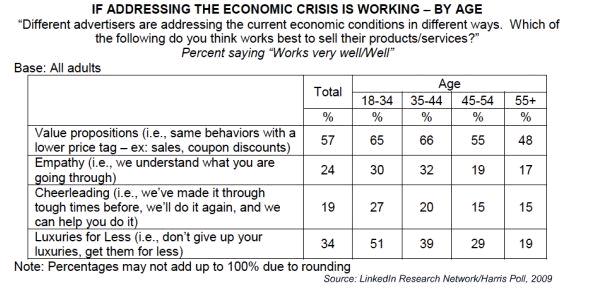The current global economy has been a tough place for quite some time, and this week’s events on Wall Street aren’t providing any reassurance that things will pick up any time soon. Throw in a bleak forecast from the federal government, and it’s enough to make a marketer wonder which way to turn.
Jen Doyle, Senior Research Manager, MarketingSherpa, and I had a recent chat on this very subject. She offered some advice to help focus marketing efforts, even when resources are tight.
It all begins with the lead …
Tight resources include time, staffing and budgets, and Jen says, “Because of this, the quick fix is sought after. The truth is, in order to get results and convert modern buyers in a struggling economy, we have to address the full spectrum of the funnel.”
She offered six big picture tactics to help uncover and convert new prospects: Read more…
Well over half of marketers report that they’re using strategies that emphasize value propositions–such as sales, coupons and discounts–to pull through the down economy. The data comes from a collaborative survey from LinkedIn and Harris Interactive, published last week.
The survey queried 1,015 advertisers between June 22 and June 30, and 2,025 adult consumers between June 24 and June 26, to get both groups’ opinions on ad effectiveness. You can read the full release here.
Three in five advertisers (61%) say they are using a value proposition strategy and almost three in five consumers (57%) say that the strategy is working ‘very well’ or ‘well’ to help marketers sell.
From the charts below, empathetic messaging was the second most reported strategy used by marketers to address the economic crisis at 39%, and 24% of consumers say the strategy is effective.




Interestingly only 18% of marketers report using a ‘luxuries for less’ strategy, while 34% of consumers say that it works ‘very well’ or ‘well’ to help sell products. This disconnect could be due to a low number of luxury product marketers in the survey–or it could be a genuine disconnect between what consumers say they want and what advertisers are giving them.
Take a look at the survey’s results to see if you are using any types of messaging or tactics that are being reported to be less effective than others. You might just be able to make a few tweaks to your efforts to boost performance.
When the economy is down and your budget is slashed, you might be forced to prove every investment. Your CEO or manager might want to see the ROI of every effort — from direct mail to responding to comments.
And who can blame them, really? Times are tight. All signs are pointing south. They want to make sure that money isn’t being wasted. You might feel the same way: you don’t want to waste part of a shrinking budget on anything that’s not guaranteed to work.
But that might not be the best way to market. Alan Scott, CMO, Dow Jones certainly doesn’t think so. Scott’s strategy is to measure every investment and interaction with the customer that he can, and to make sure overall revenue numbers are solid, he says. Getting too granular in your ROI analysis can become a distraction.
“It’s very difficult to understand the cause and effect of every individual component and make a meaningful decision,” he says. “I heard at a conference not too long ago, someone said ‘What’s the ROI of putting on pants?’ Your probably could calculate it somehow. But you have to do it [anyway].”
That’s a great line: “What’s the ROI of putting on pants?” Remember it when you’re thinking of changing a successful marketing plan just because you cannot calculate the return on every portion of it. If it works overall, why change it? Granted, it’s worth the time and effort to tweak and test, but don’t slash and burn your pants because you’re not sure how much money they make.











